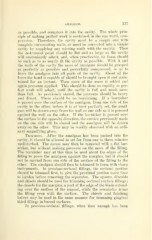Page 665 - My FlipBook
P. 665
AMALGAM. 327 ;
as possible, and compress it into the cavity. The whole prin-
ciple of making perfect work is contained in the one word, corn-
pression. Therefore, the cavity must be a simple one with
complete surrounding walls, or must be converted into a simple
cavity by supplying any missing walls with the matrix. Then
the instrument point should be flat and as large as the cavity
will conveniently admit, and, when practicable, its form should
be such as to as nearly fit the cavity as possible. With it and
the walls of the cavity the mass of amalgam should be grasped
as perfectly as possible and powerfully compressed, so as to
force the amalgam into all parts of the cavity. About all the
force the hand is capable of should be brought upon it and main-
tained for an instant. Then more of the mass is added and
again pressure applied. This should be done as rapidly as per-
fect work will admit, until the cavity is full and much more
than full. As previously stated, the pressure should be heavy
and direct. There should be no burnishing. If a burnisher
is passed over the surface of the amalgam, from one side of the
cavity to the other, before it is at least partially set, the amal-
gam will be drawn away from the wall on one side as it is pressed
against the wall on the other. If the burnisher is passed over
the surface in the opposite direction, the crevice previously made
on the one side will be closed and the amalgam will be drawn
away on the other. This may be readily observed with an ordi-
nary magnifying glass.
Teimming. After the amalgam has been packed into the
cavity, it should be allowed to set for from one to three minutes
undisturbed. The excess may then be removed with a flat bur-
nisher, but without making pressure on the mass of the filling.
The burnisher may at this time be used about the edges of the
filling to press the amalgam against the margins, but it should
not be carried from one side of the surface of the filling to the
other. The amalgam should then be trimmed to form with sharp
instruments. In proximo-occlusal fillings, the occlusal portion
should be trimmed first, to give the proximal portion more time
to harden before removing the separator. The spoons, discoids
and chisels should be used for trimming occlusal surface fillings
the chisels for the margins, a part of the edge of the blade extend-
ing over the surface of the enamel, while the remainder trims
the filling even with the surface. The chisels and finishing
knives may be used in the same manner for trimming gingival
third fillings in buccal surfaces.
In proximo-occlusal fillings, when time enough has been


